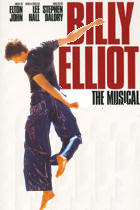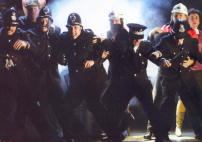|
||
Myself and the national president of the National Union of Mineworkers, Ian Lavery, along with the president of the Nottingham area of the NUM, national vice-president Keith Stanley, made a visit to the stage musical version of Billy Elliott. Three harder individuals to impress would be difficult to find. We sat in the middle near the front, arms
folded, with a sort of ‘Right, impress us’ attitude just
balancing the mental suspicion which had warned us that we might
be insulted by this show. At the end of the performance, which was
watched by large numbers of tourists ‘doing London’, an
elderly American behind me commented: “That was the most exciting
stage production I have seen in 50 years.” We were forced to
agree. |
||
|
||
|
The tensions within the family which the
show portrays predate the strike - they are not caused by it, although
they are added to by the violence, depravation and ultimate defeat.
One could draw a conclusion that the message suggests the only way
to escape this conflict is to escape the class, and with the help
of some kind, petty bourgeois join the middle class and ‘get
out of here’. That is not my interpretation. Billy goes to
that ballet school with his traditions and working class values
intact. The young people in the show who swear as much as the adults (I mean real swear words) are excellent. It is a shocking but entirely accurate portrayal of working class kids. They have three different ‘Billys’, ‘Debbies’ and ‘Michaels’ for different performances throughout the period the show runs - presumably because of their age and the time and energy playing these parts requires. The young actors playing the parts when we were there were delightful, comic and overwhelmingly enthusiastic - all the young ’uns in this show clearly are having a whale of a time and giving themselves heart and soul to their parts. There are tragic, moving, heart-wrenching, stirring sequences, powerfully presented with brilliant backdrops and props, moving rapidly from scene to scene with utter simplicity. The music is of course by Elton John, who had been so moved by the original film version that when he saw its premiere at Cannes “I had to be helped up the aisle sobbing” - so much of the film had parallels to his own early childhood, of his dreams of being able to artistically express himself. He identifies with the young Billy going against the grain, sticking to his vision, and in the process emerging from the closeting and deadening impact which small village life and lack of horizons can impose. There is a conflict here, of course, and guilt - as to whether it is even right to leave the culture and tradition of the mine (and, more importantly, its collective endeavour for social change and progress) and seek an individual way forward. Few in the pit community actually resent those who do so - in fact most take pride in athletes, scholars and artists of all kinds who make their way in a different field, so long as they never hide or betray the values and evidence of their roots. The village is behind Billy in the end not because he is escaping from them, but because he is representing them, in an arena and before an audience where few had hitherto acknowledged their existence. Billy is ironically more ‘one of them’ in his achievement in ballet than perhaps he would have been down the pit. We do have one criticism of one scene - and it was at once evident when we all three looked at each other at the same time. It is the scene where the scab donates hundreds of pounds to Billy’s efforts to get to the Royal Ballet audition. This is to suggest that the scabs were somehow just lapsed members of the community, that a ‘generous’ gift would someone demonstrate that they were ‘OK’ after all; that Billy’s endeavour was greater than the conflict between the strikers and the blacklegs. Those are entirely erroneous implications. We cannot understand the inclusion of this scene, which seems to be someone’s afterthought, since it was not in the original film version and jars sharply against the real experience of the strike. Clearly it fails to recognise the depth of utter hatred strikers feel for strikebreakers and the cheapness of their surrender, the selling of a whole community, a whole value system, and a struggle for our right to exist as a social force. If the scabs had not sold out the way they did, all the miners could have afforded to donate wads of notes - not just for this Billy, but potentially for all the Billys who could follow him in this or in other fields. One only needs look at the utter despair and loss of hope prevalent in much of the youth of the former pit villages today to see the evidence of that. It will be indescribably harder in today’s former pit communities for a Billy to emerge and blossom than it was prior to or during that epoch battle. Some have said they thought the film, and therefore the play, ends indecisively. In truth so did the strike in 85, and that is where this show leaves us. We struggled on, regrouped and had another go, and then faced the final defeat over the period of the following 10 years. That period is outside the scope of this story, so we have no problem with the ending.
|
||
|


